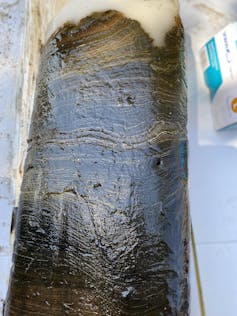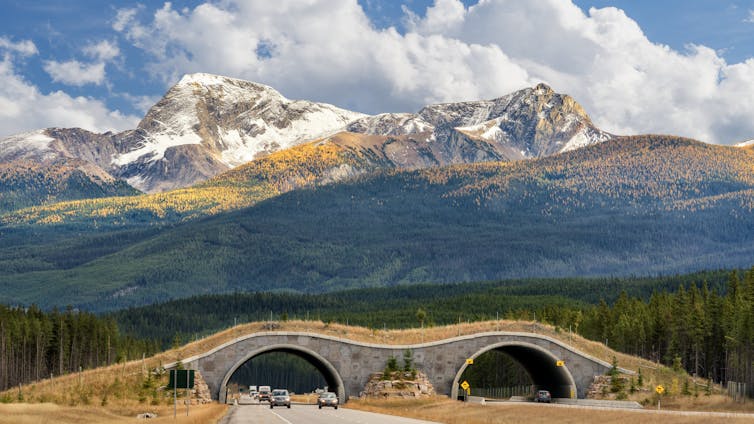When I heard that Crawford Lake in southern Ontario was selected as the “Golden Spike” candidate for placing the beginning of the Anthropocene epoch in 1950 — essentially, the best place in the world to show how humans impacted the planet’s fossil record — I was not surprised.
As the Allan and Helaine Shiff Curator of Climate Change at the Royal Ontario Museum, a metre-long sediment core from Crawford Lake was the first object I accepted into the collection as curator in April 2022.
Further, as a limnologist studying inland waters I have long understood that lakes are sentinels of climate change. Small changes in environmental conditions can lead to larger changes in a lake’s physical, chemical and biological processes, impacting the ecosystem services they provide.
In other words, nearly any lake on the planet contains many of the same Anthropocene markers (such as plutonium from nuclear weapons testing) across the same timeline.
This begs the question. Just what is so special about Crawford Lake in Milton, Ont.? And what, if anything, can it teach us about how we interact with our environments?
A local history of environmental change
As the Global Boundary Stratotype Section and Point (GSSP) Golden Spike candidate, Crawford Lake is largely special because its sediments feature visual distinctions between years, known as varving. This varving allows for particularly accurate historical dating of environmental events.
But even beyond its status as a Golden Spike candidate, Crawford Lake’s sediments tell a powerful story of human history that is both local and global.

The annual varving pattern in the sediments essentially began in the late 13th Century. It was caused by nutrient enrichment due to farming activities associated with an Attawandaron or pre-Wendat village adjacent to the lake at that time.
Moving forward, a major sediment colour shift occurred in 1874. This shift aligned with the acquisition of the land by the Crawford family who cleared trees near the lake and operated a sawmill after immigrating from England.
More recently, the sediments contain evidence of the Dust Bowl as well as the faint impact of the construction of park infrastructure near the lake and two archaeological excavations. Thus, in one continuous sediment core, we witness Indigenous and colonial local histories, as well as the global signature of an inflection point in Earth systems due to human activities.
Among other things, we’re left with an evocative record of how our environments are impacted by humans.
The impacts of intentions
The degree to which humans impact Crawford Lake’s conditions over time is not simply a function of the number of people near the lake. The early villages dating from the late 1200s through 1400s were likely home to hundreds, yet the Crawford family’s lumber business produced a much starker shift in conditions.

Today, its place within a conservation area excludes local settlement but it still draws over one hundred thousand visitors to the lake each year.
Ultimately, Crawford Lake’s sediments teach us that humans have always — and will always — change our environments in some way. But it is our cultures, discourses and attitudes towards our environment that ultimately determine what this change will look like.
It’s easy to focus on the negative impacts that humans can have on the environment. However, it’s worth embracing that humans can also live in positive, mutually beneficial relationships with the land, as has been the case with traditional Indigenous environmental management systems practised here in Canada.
Indeed, contemporary Indigenous land management practices are at least as effective, if not more, as conventional protected area approaches at preserving biodiversity.
Reversing urban impacts
As we are — for the first time in human history — a predominantly urban species, it is now more important than ever to design our cities to help ensure our urban areas create net positive outcomes to local biodiversity and climate impacts. But how can this be done?
The possibilities are as diverse as the landscapes where the cities are situated, compounded with the collective creativity of their inhabitants.
Toronto, the largest urban area close to Crawford Lake, might adopt measures being undertaken by other cities around the world, for instance creating wildlife habitat corridors connecting its existing ravine systems, and expanding the efforts of locals using their private yards as refuges for native plants.
We could see wildlife crossings on highways and streets, pollinator gardens on bus stop roofs, oversized parking lots converted to micro-forests, sidewalks widened for rain-absorbing gardens, and select streets closed to through-traffic by privately owned vehicles.

This would reduce noise and air pollution and provide those living in and visiting the city a safe, convenient, cheap and healthy alternative to driving.
The complex network of streams buried across the city might be exposed to see the light of day again, cooling down and beautifying neighbourhoods, while drawing down atmospheric carbon from riparian zone vegetation and sequestering that carbon in wetland sediments along the Lake Ontario coast.
The possibilities are endless. While these changes may sound idealistic or idyllic, they are real changes happening in major cities around the world today. In Toronto’s case, they would be building on already-existing ecologically-minded projects occurring in the city.
Read more: To attain global climate and biodiversity goals, we must reclaim nature in our cities
Repositioning ourselves within our ecosystems, to the point of considering local stewardship practices as a fundamental component of ecosystem health, may not only be smart, but necessary for our survival.
The Crawford Lake sediments present powerful evidence regarding the relationship between Homo sapiens and the planet we inhabit. Yet, perhaps the most important lesson here is that the relationship between people and planet is not predetermined, but shaped by people’s choices and values.
By positively harnessing our powers today, we can reduce atmospheric carbon dioxide concentrations and protect local biodiversity. We can tap into the best that our species is capable of, improving our quality of living along the way.
Soren Brothers does not work for, consult, own shares in or receive funding from any company or organization that would benefit from this article, and has disclosed no relevant affiliations beyond their academic appointment.
This article was originally published on The Conversation. Read the original article.







